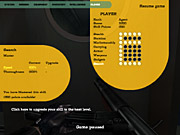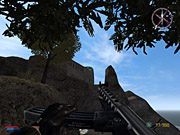No One Lives Forever 2: A Spy in H.A.R.M.'s Way--the sequel to GameSpot's 2000 Action Game of the Year, The Operative: No One Lives Forever--continues the surprising success Monolith has experienced in the last couple of years. It improves on almost everything that worked well in the first game, and it also fixes that game's problems. Thanks to this sequel, an already amazing year for action games just got even better.

Though the details have changed, the new game's story and setting are similar to those of the first game. It's still the swinging '60s, you're still UNITY agent Cate Archer, and you're still fighting the worldwide crime syndicate H.A.R.M. and its quirky henchmen. This time, you'll not only travel to predictable locations such as a remote military base, an undersea laboratory, and Japan, but you'll also visit the never-before-simulated world of Akron, Ohio, an environment that in video game terms qualifies as truly exotic.
If the story hasn't changed dramatically, the means of telling it certainly have. The expository cutscenes--which were sometimes interminable in the original game--have been seriously streamlined for the sequel. Nearly all of them make their points quickly and effectively and then move on. This skillful trimming results in scenes that are funnier and generally more entertaining than those in the original game. And from the unexpected visual gags, to the strange gadgets, to the overheard conversations of H.A.R.M.'s neurotic, chatty minions, all the other elements of the series' steadfast good humor remain intact as well.
The series' stealth elements, arguably the weakest aspect of the original's gameplay, have undergone a complete overhaul. Thankfully, a lean function has been added to Cate's repertoire of actions. Most of the game's 40 levels (spread across 15 long chapters) can be completed using stealth, brute force, or a combination of the two. And unlike in many games with a stealth element, guard alarms are usually localized--if you trigger an alert in one section of a level and manage to escape, enemies in another area won't necessarily be alerted to your presence. The designers have also done away with all the aggravating missions in which you automatically lose if you're spotted. Though triggering an alarm (especially on higher difficulty settings, where enemies pack a real wallop) will often result in a tough situation, you always have the option of fighting your way through, fleeing, or hiding until things cool down. In fact, several new gadgets, such as the bear trap and the banana peel, are specifically designed to help you escape from pursuers.
Excellent level design complements the game's improved sneaking element. Most of the environments include side passages that can be used to avoid guards. These side-passages, however, also give enemies a way to circle around you in a fight. The AI of your enemies, which was already excellent in the original, has been somewhat improved. Often, one henchman will hold his position while another one tries to work his way behind you. Meanwhile, the AI of characters who aren't actually engaged in combat has been improved dramatically. Guards will become alerted by sounds, footprints in the snow, cries from other guards, and the bodies of their fallen comrades (which you can pick up and carry out of sight). Once alerted, they won't immediately pinpoint your location. They'll first check the area of the disturbance (taking a moment to investigate dead bodies). They'll then start poking around, turning on lights and peeking into closets, in an attempt to find you. All these actions are accompanied by auditory feedback in the form of either the guard talking to his compatriots or muttering to himself. The stealth system is both intuitive enough and lenient enough to avoid the frustrating half-baked feel of similar systems implemented in other shooters, which often seem to be nothing more than an afterthought. With the possible exception of the Thief series, No One Lives Forever 2 features the most seamless and satisfying integration of first-person stealth to date.
As in the original, there are lots of bonus objects to find and extra tasks to undertake. But this time, there's an actual incentive for tackling these challenges. Skill points are awarded for completing objectives, and these points can be used to improve eight different character stats through five different levels. The effects of raised stats are noticeable without being unbalancing. For instance, improving your weapons skill will reduce the amount of time it takes to load a new clip. It's nice to have improved skills, but it's not necessary to complete a level.
The graphics are rendered using LithTech's next-generation Jupiter engine, and while they're somewhat trumped by the next-generation Unreal engine on display in the Unreal Tournament 2003 demo, they still look terrific. The Jupiter engine is capable of rendering large environments with a lot of detail, and it seems particularly suited to creating some striking water effects. But the characters in No One Lives Forever 2 are an especially notable triumph of imaginative design combined with excellent technology. Fluid animations and eyes that actually track objects permit the game's characters to truly act--a rare feat in gaming. The soundtrack is once again an endearing mix of an orchestral score and Ray Conniff-style space age pop. Also, those who played the original may notice that a new actress has provided Cate's voice work for the sequel. It's a little jarring at first, but you'll quickly adjust to it.

Facing stiff competition from games whose sole purpose is multiplayer action, the developers have concentrated on the game's great single-player experience and (possibly wisely) decided to not include any competitive online modes in No One Lives Forever 2. Instead, they've created a supplemental four-chapter campaign that can be tackled cooperatively by up to four players. The campaign is composed of reworked environments from the single-player game, and it's designed to be a true campaign experience in that you can actually save and resume online sessions. The levels do a good job of tailoring the action to a team of players. For instance, at one point you have to carry Cate's unconscious body to a safe zone, an act that requires one person to bear the load while the others to protect him or her, since you can't carry a readied weapon and a body simultaneously.
Since it's not a review until someone starts complaining, here you go: The multiplayer doesn't have a lot of replay value. Also, there might be a few too many tasks that require you to scour a level for a key object. Those criticisms might seem half-hearted--in truth, there isn't really a lot to complain about. No One Lives Forever 2 is a rousing success on every level. In an era when grim, humorless realism appears to be the sensibility of choice among shooters, a game as genuinely funny and good-natured as No One Lives Forever 2 is a welcome relief. That it's also a genuinely excellent game makes it almost too good to be true.